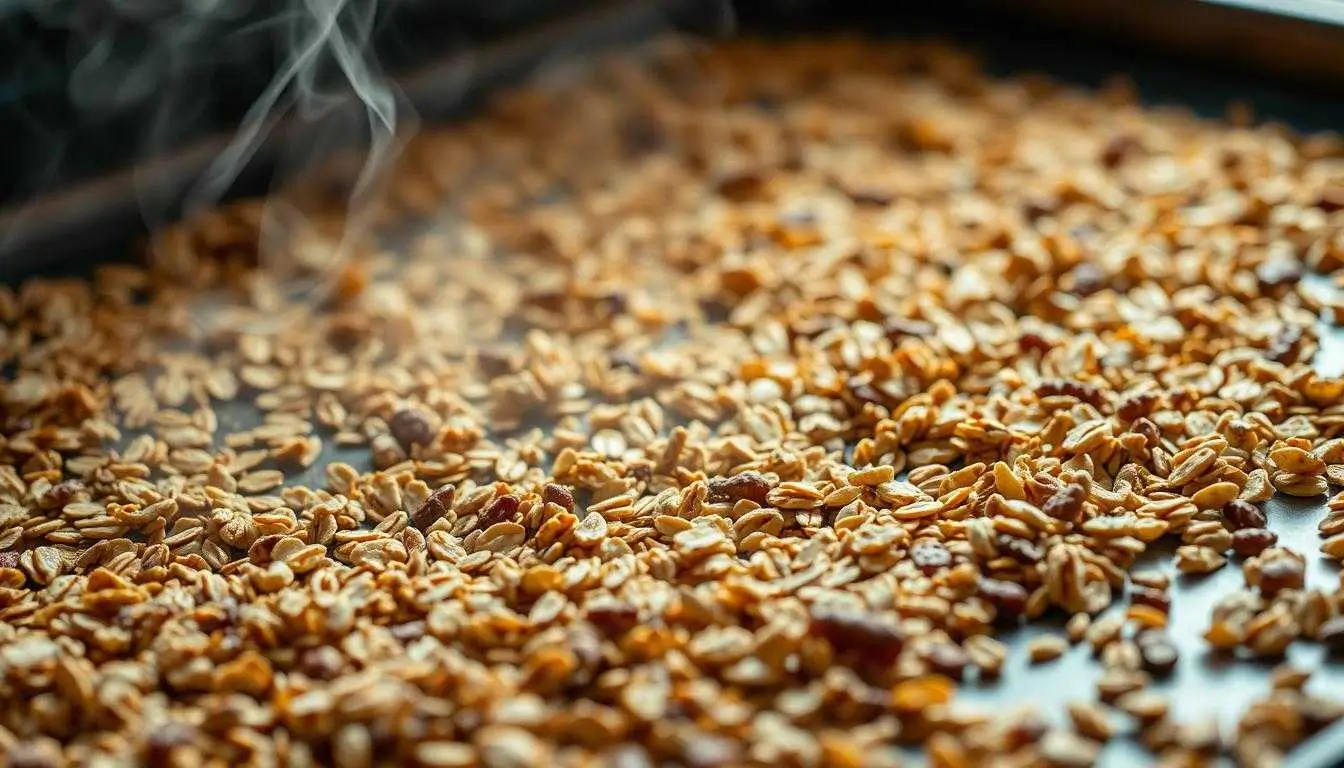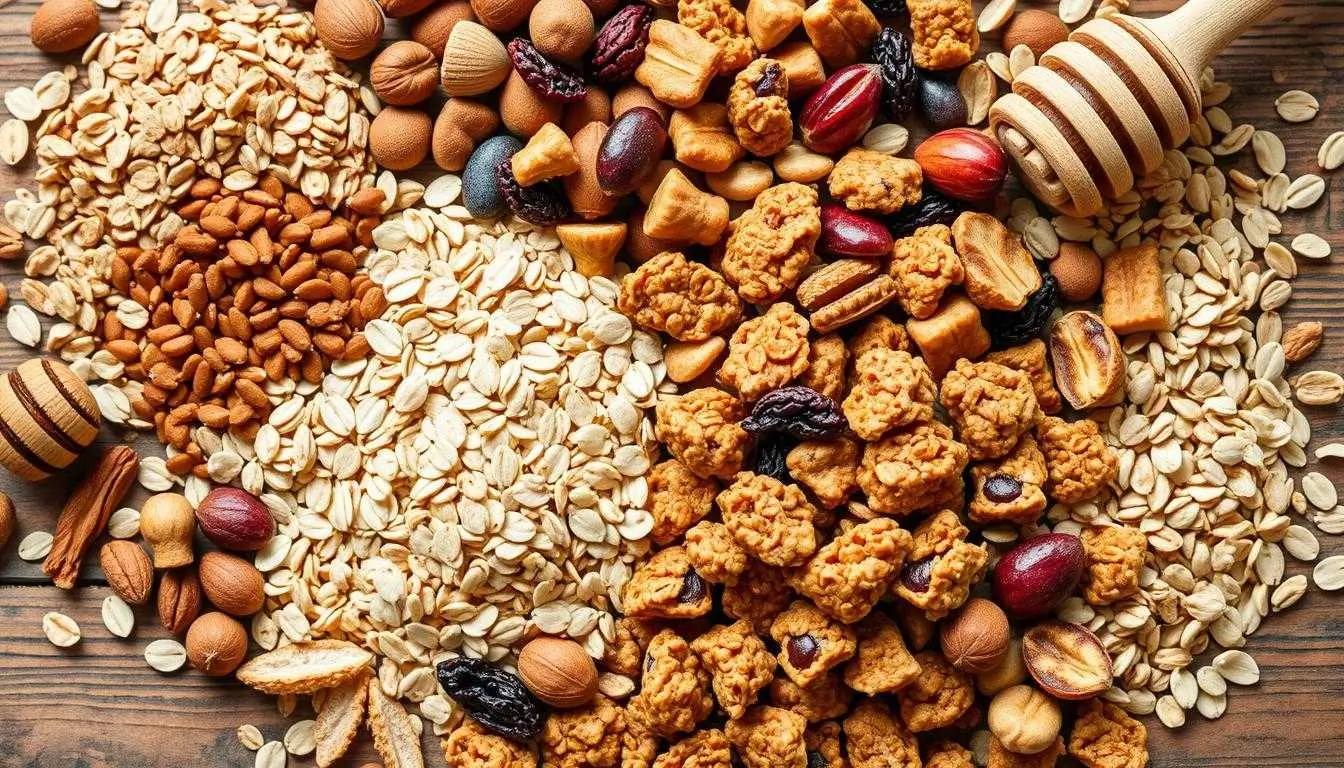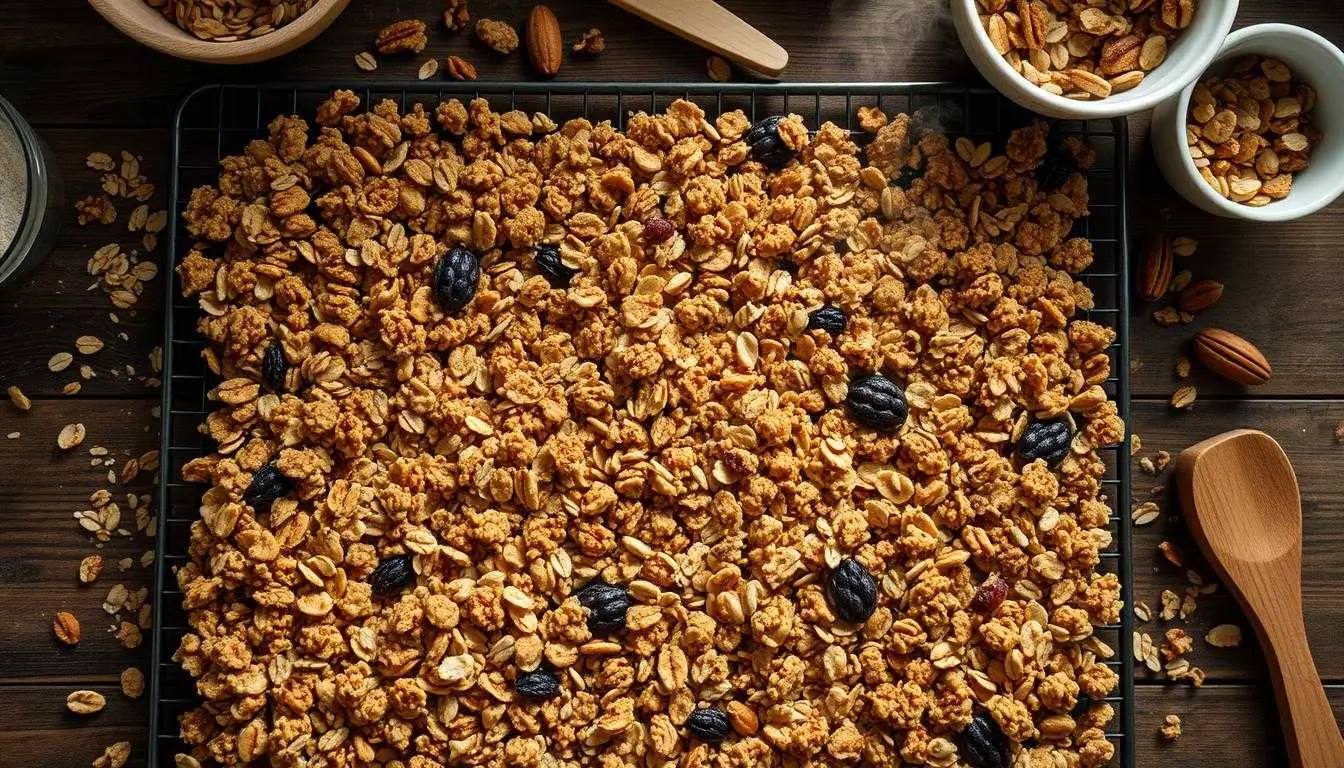Ever pulled fresh homemade granola from the oven, wondering why it doesn’t crunch right away? The magic of granola hardening turns soft, sticky oats into a crispy breakfast treat.
Your homemade granola is more than just ingredients. It’s a mix of science and flavor. As it cools, the sugars from maple syrup and olive oil crystallize, giving it that crunchy texture you love.
Understanding the granola hardening process is key to a perfect breakfast. Each batch is a story of patience, precision, and balancing wet and dry ingredients.
From spreading oats on the baking sheet to the final cooling, granola texture is an art. Rolled oats, nuts, and natural sweeteners combine to make a crunchy, satisfying treat.
Ready to explore the world of homemade granola? You’ll learn why it hardens and how to get that perfect crisp every time.
Does Homemade Granola Harden as It Cools? The Science of Perfect Crunch
Making the perfect granola is more than just mixing ingredients. It’s a science that shows how baking and cooling change everything. Your homemade granola goes through complex chemical changes that decide its texture and crunch.

The Role of Sugar Crystallization
Sugar crystallization is key to granola’s texture. When you heat sugar-based ingredients, they melt and spread. As the granola cools, these sugars solidify, making it crisp and crunchy.
- Sugar molecules align and form tight bonds
- Temperature changes trigger crystallization
- The cooling process determines final texture
Impact of Natural Oils and Fats
Natural oils from nuts and seeds are important for granola hardening. These fats solidify at different temperatures, helping to strengthen your granola.
Check out the Vanilla Nut Granola Recipe for a delicious homemade granola idea!
“The magic of granola happens when heat meets ingredients” – Culinary Scientist
Temperature Effects on Texture
Temperature is critical for the perfect granola crunch. Baking at the right temperature lets sugar and oils work together. This creates a crisp structure that keeps your granola together.
- Slow baking promotes even sugar caramelization
- Consistent oven temperature ensures uniform texture
- Controlled cooling prevents moisture retention
Knowing these scientific principles turns making granola into a precise art.
Essential Ingredients That Affect Granola’s Texture

Making the perfect granola starts with knowing how each ingredient affects its texture. The crunch and taste of your granola depend on picking the right ingredients and balancing them well.
Old-fashioned rolled oats are at the core of any great granola. They give the granola its structure and soak up flavors well. Choose thick-cut oats for a sturdy base in your homemade treat.
Key Ingredients for Optimal Texture
- Nuts: Almonds, pecans, and hazelnuts add a lot of crunch and flavor
- Seeds: Pepitas and sunflower seeds bring nutrition and texture
- Coconut flakes: They add crispiness and a touch of sweetness
Natural oils are key in binding your granola ingredients. Coconut or olive oil helps make those tasty clusters and boosts crispiness. Adding natural sweeteners like maple syrup or honey makes the granola golden and crunchy.
“The secret to great granola is balancing your dry and wet ingredients with precision.” – Culinary Experts
Try mixing different nuts, seeds, and oats to find your perfect granola texture. The right mix of ingredients is key to a satisfying, crunchy breakfast or snack.
Does homemade granola harden as it cools?
Making the perfect homemade granola means knowing how it cools. When you take it out of the oven, it might feel soft. But don’t worry, it will harden as it cools.
The granola’s transformation is quite interesting. It happens naturally as it cools. Several important changes occur:
Chemical Transformations During Cooling
- Sugars start to form crystals
- Natural oils turn solid
- Ingredients come together to form clusters
Understanding Hardening Time
Being patient is key when cooling granola. Let it rest for 45-60 minutes without touching it. Don’t stir or touch it during this time!
Learn how to achieve the perfect texture with How to Make Granola Crunchy and Not Chewy.
Signs of Perfect Granola Setting
- It turns golden-brown all over
- It becomes crisp and dry
- Clusters start to form
- It should not feel soft or sticky
“The secret to crunchy granola is letting it cool completely without disruption.” – Baking Experts
Discover tips to fix your granola with Why Is Homemade Granola Not Crunchy?
Your homemade granola will get crunchier as it cools to room temperature. Knowing these changes helps you make a deliciously crunchy treat every time.
The Perfect Balance of Wet and Dry Ingredients
Making the best homemade granola is all about finding the right mix of wet and dry ingredients. The success of your recipe depends on getting this balance just right. It’s what makes your granola both tasty and textured perfectly.
When you’re making your granola, keep these important parts in mind:
- Dry ingredients: Rolled oats, nuts, seeds
- Wet ingredients: Oils, sweeteners, binding agents
- Recommended ratio: 3 cups dry to 1 cup wet ingredients
Getting the wet and dry ingredients in balance is key. Too much wet stuff can make your granola soggy. Too little, and it’ll be dry and crumbly. You want a mix that coats every dry ingredient evenly.
“Precision in ingredient proportions transforms ordinary oats into extraordinary granola.”
Here are some tips to help you get your wet and dry ingredients just right:
- Use extra virgin olive oil (1/4 cup) to help bind ingredients
- Add egg whites (1/4 cup) as a secret binding agent
- Try natural sweeteners like brown sugar or coconut sugar
With the right balance of wet and dry ingredients, you’ll end up with granola that’s crunchy, full of flavor, and just right in texture.
Proper Baking Techniques for Optimal Crunch
Baking granola has its own charm, which adds a special touch to it in a homemade version. It’s all about the right temperature, timing, and pan choice. All put together work to make your granola crispy and delicious.
Temperature Control Methods
Getting the oven temperature just right is key to perfect granola. Experts suggest baking at 300-325°F (140-150°C). This slow heat helps dry out the ingredients evenly, preventing them from burning.
- Use an oven thermometer for precise temperature tracking
- Avoid high heat that can quickly scorch your ingredients
- Keep the oven rack in the middle position for uniform heating
Timing Your Bake
The time you bake your granola is also important. It usually takes 20-25 minutes. Stir the granola every 10-15 minutes to ensure it browns evenly.
The key is patience: low temperature and consistent stirring create the ultimate crispy texture.
Pan Selection and Preparation
A proper pan is necessary for the baking of truly great granola: a large-rimmed baking sheet with a light-colored surface so that it doesn’t become overly brown. Parchment paper makes cleanup easy and helps prevent sticking.
- Select a rimmed baking sheet with plenty of surface area
- Line the pan with parchment paper
- Spread granola mixture in a thin, even layer
By using these baking techniques, you’ll make a crunchy, golden granola that will wow everyone.
Best Natural Sweeteners for Crispy Granola
Making the perfect homemade granola begins with picking the right sweeteners. Maple syrup and honey are top picks. They add sweetness and texture to your granola.
Natural sweeteners are key to achieving that crunchy texture everyone loves. They do more than sweeten. They help mix ingredients and form those tasty clusters.
- Maple Syrup: A rich, complex sweetener that adds depth to granola sweetness
- Honey: Creates a perfect binding agent for crispy clusters
- Coconut Nectar: Another fantastic natural option with unique flavor profiles
“The secret to amazing granola is balancing natural sweeteners with other ingredients.”
When picking your sweetener, keep these tips in mind:
- Use about 1/2 cup of natural sweetener per 3 cups of oats
- Experiment with mixing different natural sweeteners
- Adjust quantities to match your taste preferences
Pro tip: Maple syrup provides a richer flavor profile, while honey offers more binding properties for your granola clusters.
Forget refined sugars and go for these natural options. They taste better and offer health benefits. Your homemade granola will be grateful!
How to Achieve Cluster Formation
Making perfect granola clusters is an art. It needs the right techniques and ingredients. With practice, your homemade granola will go from loose oats to crunchy clumps.
The secret to great granola clusters is in the mixing and baking. You want a mix that sticks together but stays crunchy.
Pressing Techniques for Optimal Clusters
Here are some pressing techniques to try:
- Press the granola mixture firmly with a spatula halfway through baking
- Create an even layer about ½-inch thick on the baking sheet
- Avoid stirring during the initial cooling phase
Ingredient Ratios for Perfect Clusters
Getting the right ingredient ratios is key for clusters. Our mixed berry granola recipe shows the best mix:
- Old-fashioned oats: 48.3% (about 1½ cups)
- Binding agents:
- Egg whites (2.1%)
- Chia seeds (3.3%)
- Cashew butter (3.1%)
- Sweeteners:
- Maple syrup (4.0%)
- Cane sugar (2.3%)
“The key to great granola clusters is patience and precise technique.”
Bake your granola at 350°F for 22-26 minutes. Let it cool in the pan for 15-20 minutes without moving it. This helps the clusters set and stay in shape.
Pro tip: Use egg whites or chia seeds mixed with water as a natural binder. This will make your granola clusters irresistible. They’re perfect for snacking or on top of yogurt.
Storage Methods to Maintain Crunchiness
Keeping your homemade granola crunchy is all about the right storage. The right method can make it stay fresh and crispy for a long time.
Choosing the right airtight container is key. Glass jars or hard plastic containers are best. They keep your granola away from moisture and air.
- Room temperature storage: Up to 1 month in an airtight container
- Refrigerator storage: Extends freshness to 2 months
- Freezer storage: Preserves quality for up to 3 months
“The secret to crispy granola is keeping it away from humidity and sealing it properly.” – Culinary Experts
If your granola loses its crunch, don’t fret. You can make it crunchy again. Just spread it on a baking sheet and warm it in a low oven for 5-10 minutes.
Pro tip: Always let your granola cool down before storing. Heat can cause moisture, making it soggy. Patience is key for that perfect crunch!
Remember: Proper storage is the difference between enjoyable, crispy granola and a disappointing, soft mixture.
Common Mistakes That Affect Granola Texture
Making the perfect homemade granola can be challenging. Knowing common mistakes helps you fix texture problems and get that crispy, tasty result every time.
Baking is where most texture issues happen. Overbaking makes granola burnt and hard, losing its crunch. Underbaking makes it chewy and soft, missing the crisp texture.
“The secret to perfect granola is mastering temperature and timing.”
Here are the key tips for the perfect granola texture:
- Liquid Ratios: Too much liquid makes granola soggy, too little prevents clusters
- Stirring Technique: Stirring too much during baking ruins cluster formation
- Cooling Process: Let granola cool completely to stop moisture buildup
- Ingredient Distribution: Make sure wet and dry ingredients are evenly coated
Temperature control is key for granola texture. Baking at 350°F for 10-15 minutes gets it golden-brown. Keep an eye on it in the last few minutes to avoid burning.
Remember, practice makes perfect. Each batch of granola is a chance to improve your technique and see how ingredients work together during baking.
Conclusion
Making a tasty, healthy snack at home is like an art. It mixes science and creativity. You get to pick every ingredient, texture, and flavor. The tips in this guide will help you make a crunchy, nutritious treat that’s better than store-bought ones.
Knowing how to make granola lets you tailor your recipe just right. You can manage sugar crystallization and control baking temperatures. Each step helps you get that perfect crunch. Plus, you have full control over what goes into your snack.
As it is practice that brings improvement in granola making skills, he advises trying various mix-ins, sweeteners, and baking techniques for a particular recipe unique to one palate. It also claimed that proper cooling and storing is key to its crunchy texture.
Homemade granola is more than just a snack. It’s a journey into the world of food. By learning these skills, you’ll make a snack that’s not only delicious but also healthy. It can make breakfast better, be a quick snack, or a thoughtful gift for others.
FAQs
Does granola harden as it cools?
Yes, homemade granola does harden as it cools. When you first remove it from the oven, granola may still feel soft or pliable. However, as it cools, the sugars and fats solidify, binding the ingredients together and creating that crunchy texture everyone loves.
Why is my homemade granola not crunchy?
If your homemade granola isn’t crunchy, it might be due to undercooking, overcrowding the baking sheet, or using too much moisture in the mix. Properly spreading out the granola in a single layer and ensuring it bakes until golden brown can help. Remember, does homemade granola harden as it cools? Yes, but if it doesn’t crisp up after cooling, it likely needs more time in the oven.
How to tell if homemade granola is done?
Homemade granola is done when it turns a golden-brown color and gives off a fragrant, toasted aroma. It may still seem soft when hot, but this is normal. A key question to keep in mind is: Does homemade granola harden as it cools? Yes, so trust the cooling process to achieve the final crunchy texture.
How to keep homemade granola crunchy?
To keep homemade granola crunchy, store it in an airtight container at room temperature to prevent it from absorbing moisture. Additionally, ensure it cools completely before sealing it. Since does homemade granola harden as it cools? is a critical factor, letting it cool thoroughly on the baking sheet ensures optimal crunchiness for long-term storage.

